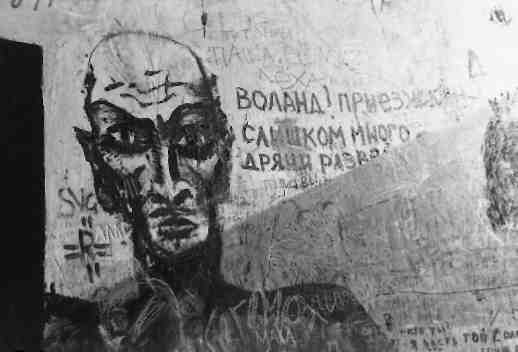the graveyard attached to the Alexander Nevsky monastery in Leningrad-St Petersburg.)
There is an obvious link between the treatment of writers’ remains and the ‘translation’, or removal to a new site, of relics that was a requisite step in the creation of the cult of an Orthodox saint. Reverence for writers was a form of secular religion, and the materialism that was a central dogma of Marxism-Leninism expressed itself in a literal-minded determination that memorials should actually enshrine the dust of the departed. The connection between religion and literature was also brought home by the arrangements for the 1937 jubilee, described in advance by the newspaper
The blatancy with which literature was presented as an alternative religion (and the association of this, during the Stalin era, with the ruler’s own ‘cult of personality’) was perhaps the only peculiarly ‘Soviet’ aspect of post-revolutionary writers’ cults. In many other ways, these simply perpetuated the past. Literary museums as well as statues had begun to multiply before the Revolution: an example was Tolstoy’s Moscow house, opened to the public as early as 1911, a year after the writer’s death. And ‘museum apartments’ remained popular places for self-educating visits in the post-Soviet period too. Indeed, the years after 1991 saw the founding of numerous museums as the result of private initiative (for instance, in the apartment once inhabited by Anna Akhmatova in the Sheremetiev Palace, St Petersburg, or the house
where Marina Tsvetaeva lived in the Arbat district of Moscow). The bicentenary of Pushkin’s birth in 1999 may have had commercial spin-offs of a kind not witnessed for a hundred years (such as the reappearance of Pushkin vases and Pushkin matchboxes) as well as some never seen before (for instance, an Internet ‘postcard’ showing Pushkin kicking Danthes in the nether regions and then kissing Natalya). But it was also marked by a crop of entirely conventional monuments – such as a hideous gilded statue of Pushkin and his wife in the Moscow Arbat, with the poet shown slightly taller than Natalya, rather than a head shorter, as he was in reality. (Ill. 6.)
The capacity of writer cults to withstand historical vicissitude has been striking. Monuments and memorials to authors not only survived the revolutionary iconoclasm of the first decade of Soviet rule, but stayed in place during later statue-toppling frenzies as well. Dostoevsky’s effigy remained in its position outside his birthplace throughout the Stalin years; A. N. Tolstoy, an instrument and beneficiary of literary Stalinism, was spared from the post-1961 monument purge that rid Soviet cities of images of his master; Fadeev, an assiduous signer of arrest- warrants during the Great Terror, went on standing on his pedestal when the memorial to Feliks Dzerzhinsky, the founder of the Soviet secret police, was torn down by Muscovites protesting against the coup by hardline Communists in August 1991. The only exception to the general rule of conservation was the museum flat of Nikolay Ostrovsky, part of which was turned in the late 1990s into an exhibition of waxworks. But this one instance most certainly did not point to a decline in reverence for literary figures in general.
The commemorative efforts of twentieth-century British lovers of literature (discreet blue plaques on London houses and the like) pale into insignificance before Russian ones. Different, too, is the place of the memorials in popular culture. It would be, to put it mildly, unusual if a couple decided to begin their honeymoon with a visit to Stratford (as a Russian couple might with a visit to Pushkin’s estate in Mikhailovskoe);
even the most famous writers’ museums (for instance, the Bronte house in Haworth) attract a less socially diverse group of visitors than their Russian equivalents. What is more, the existence of commemorative cults has, since the late nineteenth century, been what the Formalist scholar Yury Tynyanov termed a ‘literary fact’, that is, a point in real life that is of significance to literary composition.
Writers varied considerably in their attitudes to the memorialization of their predecessors, and to the possibility that they might one day themselves be memorialized. For some early twentieth-century poets, for example Innokenty Annensky and Anna Akhmatova, evoking a statue was a way of emphasizing continuity between past and present. Both poets imagined Pushkin’s bronzes coming back to life, walking among the avenues of Tsarskoe Selo that he had celebrated in his poetry. Later, Akhmatova was to conclude her poetic commemoration of the Great Terror,

5. Graffiti showing Woland from
prison, Kresty. The statue would be a perpetual admonition to the city’s population of the tragedy that
And let the melted snow stream Off the immobile, bronze eyelids,
And let the prison dove coo in the distance, And the ships peacefully sail down the Neva.
Akhmatova was also to allude in some of her work to the custom of naming streets after famous writers, as a way of raising the question of what traces her life would leave in the future. So too was the poet Osip Mandelstam in the bleak days of exile in 1935, when physical survival came to seem more and more unlikely:
Whichever street is this?
Mandelstam Street.
What sort of damn name is that?
However you turn it about
It sounds crooked, not straight.
The street was crooked, not straight,
And he was black, not white, in his ways,
That’s why this street,
Or, rather, this pit –
Has its name:
After that Mandelstam.
The fictional Mandelstam Street has acquired its name by a grotesque reversal of the usual process by which such names were assigned. A side-street instead of a main one has been picked, and instead of conferring immortality and transcendence, it recalls death and constriction. The word ‘pit’ (

